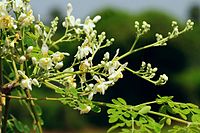
Photo from wikipedia
The anti-diabetic activity of extracts, fractions and compounds of Moringa oleifera have been reported; however, several constituents from this well known medicinal plant are not yet screened for bio-perspecting role… Click to show full abstract
The anti-diabetic activity of extracts, fractions and compounds of Moringa oleifera have been reported; however, several constituents from this well known medicinal plant are not yet screened for bio-perspecting role for diabetes. Current studies demonstrated the anti-diabetic properties of five chemical constituents of the plant viz, 4-hydroxyphenylacetonitrite (1), fluoropyrazine (3), methyl-4-hydroxybenzoate (4), vanillin (5), and 4-α-L-rhamnopyranosyloxybenzyl isothiocyanate (6) along with one related compound 3,4-dihydroxy benzonitrile (2) for the first time in vitro and in vivo. Furthermore, the mechanism of action of compounds was predicted by utilizing molecular docking with protein kinase A (PKA) and exchange protein activated by cAMP (Epac2A). The structure of compounds was elucidated by UV, IR, MS, and 1H NMR. The compounds 1, 3–5 induced significant insulin secretion at stimulatory (16.7 mM) glucose, but not at basal (3 mM) glucose concentration, and compound 3 seems to be the most active. Compounds 1, 3–5 showed dose-dependent insulin secretory activity with optimum response at 200 μM. In silico studies revealed that compound 3 has a noticeable electrostatic and hydrophobic interaction with protein kinase A (PKA). In vitro studies also showed that there was significant reduction of compounds 1–3 mediated insulin secretion in the presence of PKA inhibitor suggesting that there is a possible role of PKA signaling pathway on insulin secretion. Upon oral administration of 1, 3–5 to diabetic rats, compounds 1 and 3 significantly reduced blood glucose level in diabetic rats in a dose- and time-dependent manner. The oral glucose tolerance test in diabetic rats showed that compound 3 significantly enhanced plasma insulin and improved beta-cell function. In cytotoxicity assay, compounds 1, 3–5 did not show any toxic effect upto 200 μM. The insulin releasing characteristic of different constituents from M. oleifera conceivably correlate the lowering of blood glucose in in vivo diabetic rats by triggering glucose-induced insulin secretion from pancreatic islets possibly by PKA-mediated insulin secretory pathway.
Journal Title: Medicinal Chemistry Research
Year Published: 2018
Link to full text (if available)
Share on Social Media: Sign Up to like & get
recommendations!